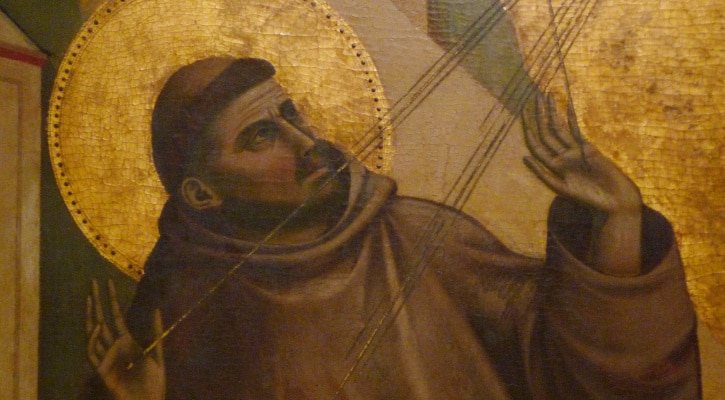Photo: Steven Zucker, Smarthistory/Flickr
The Greek word stigma means “a scar left by a hot iron: brand,” according to Merriam-Webster’s Collegiate Dictionary (Eleventh Edition). Stigmata—the plural form of the same Greek word—can also mean “bodily marks resembling the wounds of the crucified Christ.” This provides a basic background for understanding the mysterious phenomenon of the stigmata in Christian history.
I begin my reflections on the mystery of the stigmata by confessing that the first person I think of as having such bodily marks, apart from Jesus, is St. Francis of Assisi, who died in 1226. As the founder of the Franciscan Order, St. Francis is certainly a primary shaper of Franciscan spirituality. St. Francis, therefore, is a preeminent focal point in helping us contemplate the meaning of the wounds of Christ and of his own wounds and thus to come to a Franciscan understanding of suffering.
The Crucified Christ Appears to Francis
On two separate, dramatic occasions, Francis had a vision of Jesus, wounded in hands, feet and side, suffering on a cross. If we look carefully at the two visions we will see them as closely interrelated. Both visions are described in St. Bonaventure’s Life of St. Francis. It’s helpful to remember that Bonaventure, as a Franciscan theologian and spiritual writer, often described God as a God of overflowing goodness and love.
The first vision happened to Francis shortly after his conversion from a rather worldly life. After that experience, Bonaventure tells us: “One day, while Francis was praying in a secluded spot and became totally absorbed in God through his extreme fervor, Jesus Christ appeared to him fastened to the cross. Francis’ soul melted at the sight, and the memory of Christ’s passion was so impressed on the innermost recesses of his heart that from that hour, whenever Christ’s crucifixion came to mind, he could scarcely contain his tears and sighs.”
Bonaventure points out that from that time on Francis began “rendering humble service to lepers with human concern and devoted kindness….He visited their houses frequently, and generously distributed alms to them and with great compassion kissed their hands and their mouths.”
Francis’ Vision on Mount La Verna
About two years before his death, St. Francis had a second vision of Christ fastened to the cross. Here is how St. Bonaventure sets the scene in his Life of St. Francis: “On a certain morning about the Feast of the Exaltation of the Cross [September 14], while Francis was praying on the mountainside, he saw a Seraph with six fiery and shining wings descend from the height of heaven. And when in swift flight the Seraph had reached a spot in the air near the man of God, there appeared between the wings the figure of a man crucified, with his hands and feet extended in the form of a cross and fastened to a cross. Two of the wings were lifted above his head, two were extended for flight and two covered his whole body.
“When Francis saw this, he was overwhelmed and his whole body was flooded with a mixture of joy and sorrow. He rejoiced because of the gracious way Christ looked upon him under the appearance of the Seraph, but the fact that he was fastened to a cross pierced his soul with a sword of compassionate sorrow.”
This is a good place to say a word about the Seraph. Seraphs are those angels closest to God, burning with love as they bow before the Most High God, shouting “Holy, holy, holy!” (see Isaiah 6:2-3.) Their fiery wings, as depicted here, suggest the flaming intensity of God’s love that Christ communicated to Francis, which in turn, set Francis’ heart afire. The word seraphic is often used to describe Francis’ passionate style of relating to God and is often applied to the whole Franciscan Order, which is sometimes called the Seraphic Order.
The Meaning of the Stigmata
As suggested earlier, St. Francis is an important key for us in unlocking the meaning of Christ’s Stigmata. September is a good month to contemplate the meaning of the Stigmata for any of us who consider ourselves followers of St. Francis. As many of us know, Franciscans celebrate the Feast of the Stigmata of St. Francis of Assisi each year on September 17, which is an estimated date of his receiving the wounds of Christ at Mount La Verna in 1224, two years before his death.
When St. Francis saw in his vision of the Crucified Christ the incredible outpouring of God’s love upon him, he was inspired to respond with the same kind of overflowing love. We too contemplate that vision and try to respond in the same spirit.
Prayer
Lord Jesus Christ, we praise you and adore you.
Like Francis, we are amazed that you held nothing back from us in pouring yourself out
for us so totally through your holy wounds on the cross. We ask you to breathe forth your Holy Spirit into us and set our hearts on fire,
so that, with the Spirit’s help, we might respond more fully to you. Amen.









3 thoughts on “Reflections on the Stigmata of St. Francis”
My whole life changed after having the Franciscan at Most Holy Redeemer Parish in Tampa Florida. God Bless them all and always 🙏 ❤
Some holy souls such as Francis embody the greatest of all virtues….humility. Francis was so consumed with the.love of Jesus in it’s totality even and especially the passion of Jesus. God in His Wisdom granted this grace to Francis. Redemptive suffering with Jesus.
I read all I can on Francis and Clare